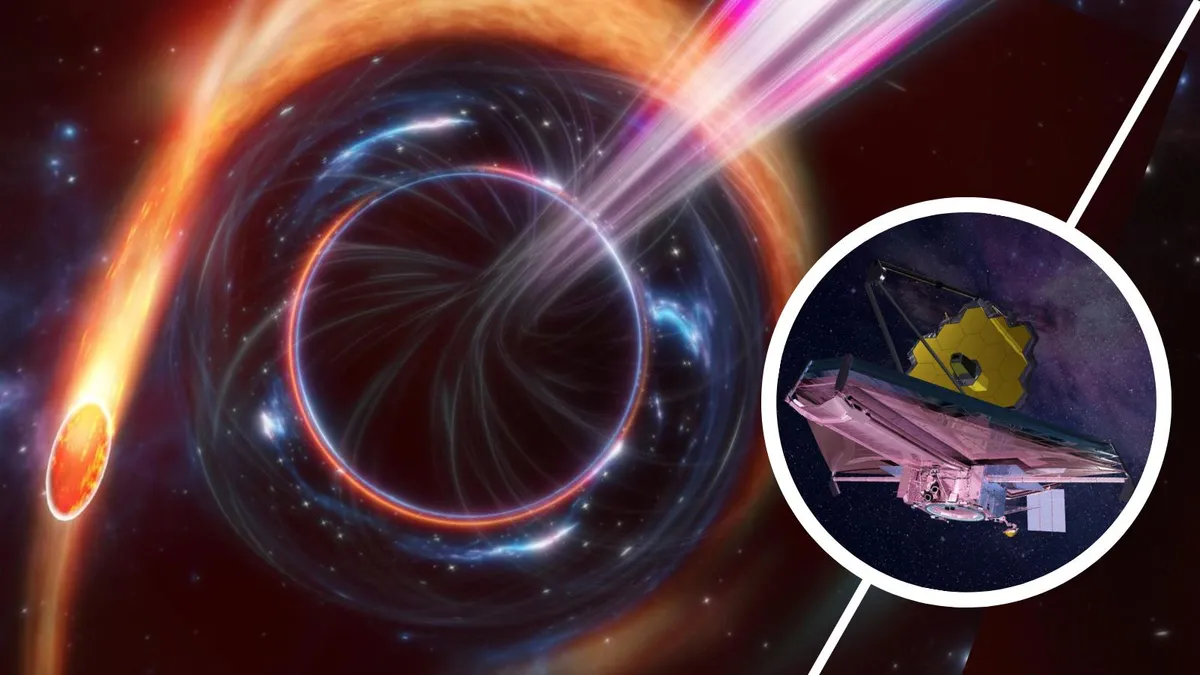
Astronomers have achieved a groundbreaking milestone with the James Webb Space Telescope (JWST), unveiling its first glimpses into the universe's most chaotic and destructive events: stars being torn apart and consumed by supermassive black holes. This powerful space telescope has identified black holes lying dormant in dusty galaxies, patiently waiting for their stellar victims to approach.
Utilizing the capabilities of the James Webb Space Telescope, a team of researchers focused on several instances of what are known as tidal disruption events (TDEs). TDEs occur when a supermassive black hole at the center of a galaxy captures a passing star, tearing it apart and unleashing an enormous amount of energy. Since the first observation of a TDE in the 1990s, approximately 100 such star-destroying events have been identified by astronomers.
Recent observations made by the JWST suggest that these violent incidents may be prevalent in galaxies obscured by dense gas and dust, rendering them invisible to traditional observation methods. “These are the first JWST observations of TDEs, and they look nothing like what we've ever seen before,” stated Megan Masterson, the study team leader and a researcher at the Massachusetts Institute of Technology. “We've learned these are indeed powered by black hole accretion, and they don’t resemble the environments around typical active black holes.”
But how does a supermassive black hole conceal its consumption of stars? The process begins when a star's orbit brings it dangerously close to a supermassive black hole, which can possess a mass millions or even billions of times greater than that of the Sun. This immense mass creates a powerful gravitational pull, leading to strong tidal forces acting upon the doomed star, a phenomenon whimsically referred to as spaghettification. During this stage, the star is stretched vertically and compressed horizontally.
Interestingly, the stellar remnants do not plunge directly into the black hole. Instead, they form a swirling, flattened structure known as an accretion disk around the black hole, gradually feeding its material. The same tidal forces that distort the star cause the accretion disk to emit bright light. Meanwhile, a portion of the star's matter is funneled toward the poles of the black hole, where it accelerates nearly to the speed of light, resulting in the ejection of high-energy jets. These jets emit electromagnetic radiation, enhancing the visibility of TDEs across various wavelengths.
While most TDEs are detected in optical and X-ray radiation, observing these events in distant dusty galaxies poses significant challenges. Dense clouds of dust and gas can absorb electromagnetic radiation in optical and X-ray wavelengths, making TDEs in such environments hard to spot. However, infrared light is less susceptible to absorption by dust clouds, and the JWST is the most sensitive infrared telescope ever constructed.
The study team directed the $10 billion space telescope toward four dusty galaxies suspected of hosting TDEs. Remarkably, the JWST identified the infrared signatures of supermassive black holes consuming stellar material from their accretion disks.
The team used the JWST to confirm TDEs in these galaxies by detecting a specific infrared emission resulting from black hole accretion. This emission occurs when the intense radiation from the accretion disk strips electrons from surrounding atoms, thereby ionizing them. In particular, the ionization of neon results in the release of infrared radiation at a precise wavelength, which the JWST can easily detect. “There's nothing else in the universe that can excite this gas to these energies, except for black hole accretion,” Masterson explained.
Investigating 12 potential TDE sites, the team found the neon fingerprint in four of them, including the closest TDE to Earth, located 130 million light-years away. Confirming the presence of supermassive black hole accretion in these galaxies was just the beginning. The team aimed to uncover whether these black holes were constantly consuming material or lying dormant, waiting for stars to wander too close.
The JWST observations revealed significant differences in the matter of these galaxies compared to that in active galaxies, where supermassive black holes continually feed on surrounding material. Active galaxies typically feature clumpy, doughnut-shaped dust clouds around their black holes. In contrast, the four dusty galaxies studied displayed distinctly different patterns, suggesting that the supermassive black holes were dormant until their stellar meals ventured into their vicinity.
“Together, these observations confirm that the only explanation for these flares is TDEs,” Masterson stated. The next step for astronomers is to identify more currently obscured TDEs, which could provide deeper insights into these cosmic events. This increased data will help determine the amount of stellar material supermassive black holes consume and the duration of the TDE process.
Masterson emphasized that the process of a black hole consuming stellar material is gradual and not instantaneous. The goal is to explore how long this process takes and what the environment surrounding these black holes looks like. As the research continues, astronomers hope to decode fundamental properties of supermassive black holes, including their spin rates and mass.
In conclusion, the James Webb Space Telescope is revolutionizing our understanding of cosmic phenomena, revealing the hidden violence of the universe and offering new avenues for exploring the mysteries of supermassive black holes.